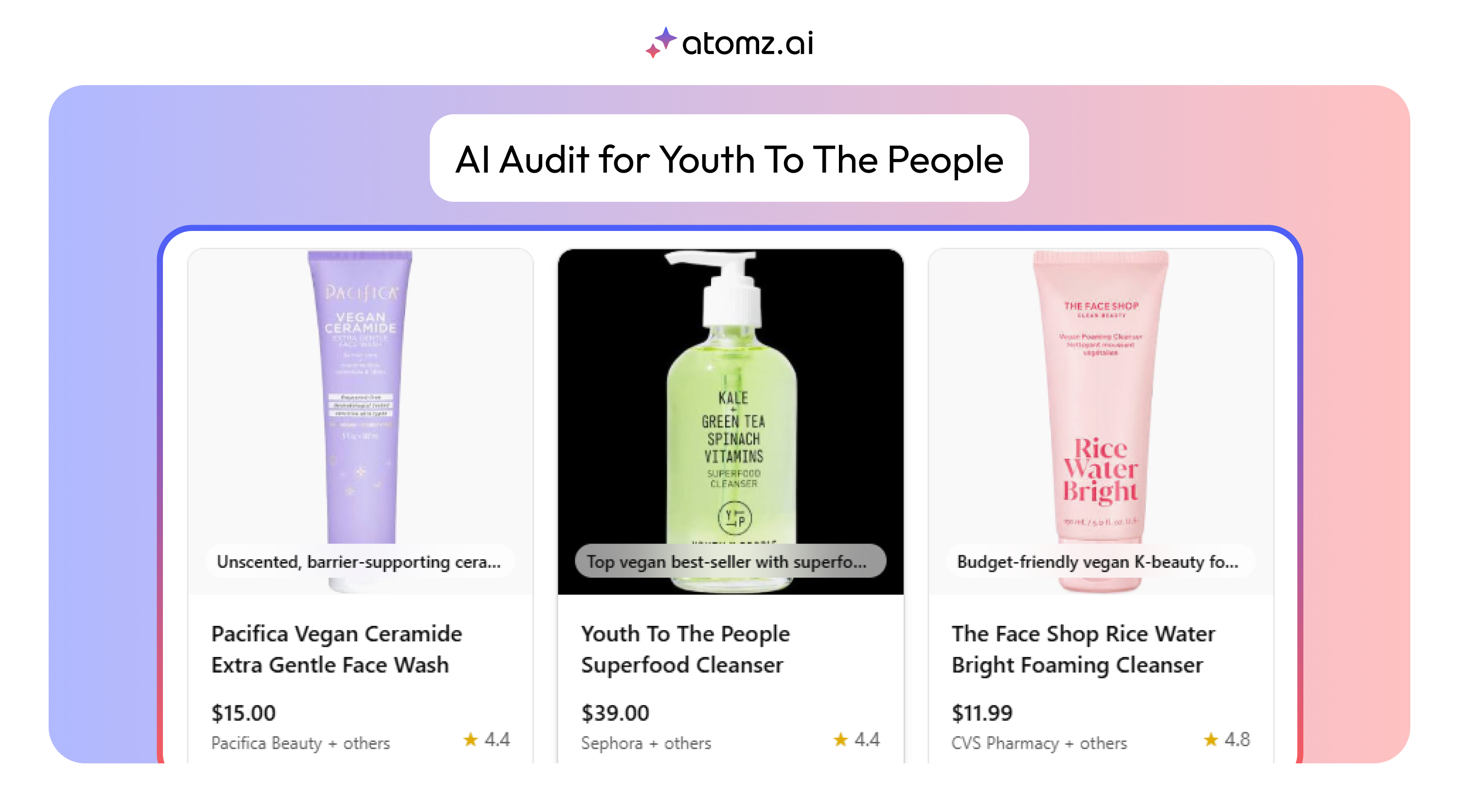
ON THIS PAGE
Stay Updated with latest in AI SEO
21 November 2025
How do ingredient-focused beauty brands perform in AI-driven searches?
To find out, I put Youth to the People, famous for its “superfood skincare” positioning, to the test, checking how visible they are when someone asks ChatGPT for clean beauty products.
Before diving into the Youth to the People results, you can check your brand's general AI readiness right now.
Test Your Brand's AI Visibility →
Takes 2 minutes. See how your brand performs across different AI systems.
Test how your beauty brand performs across the complete AI discovery spectrum with these 10 strategic queries:
Tests: Do you own your product category in AI recommendations?
Tests: Does AI recommend you for your signature ingredients?
Tests: Do you appear when customers describe their skin needs?
Tests: How does AI categorize you vs competitors?
4 out of 10 queries (40% visibility)
Scoring approach: 8+ mentions = strong visibility | 4-7 = mixed results | under 4 = limited visibility
Here's what happened with each search:
Result:
Featured prominently
What appeared instead:
OSEA Undaria Algae Body Oil ($48), Herbivore Lapis Facial Oil ($72), True Botanicals Vitamin C Booster ($90)
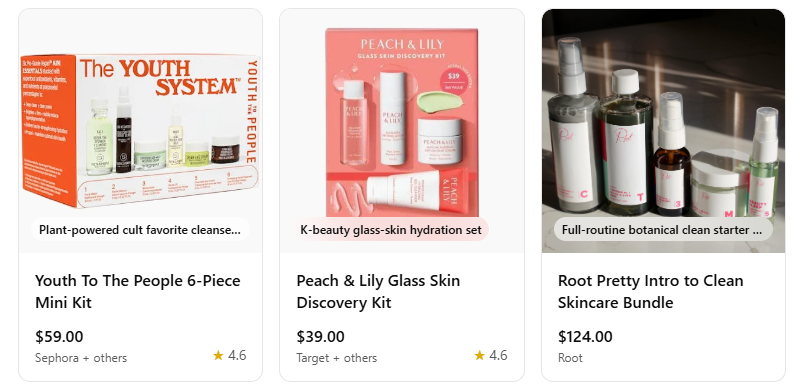
My take:
It’s great to see Youth to the People show up in the results for these core clean skincare queries. Their presence alongside well-known competitors reinforces their position in the ingredient-driven, eco-conscious skincare space, and shows that they’re in the conversation where conscious beauty shoppers are looking.
Result:
Missing entirely
What appeared instead:
Eminence Organic Stone Crop Gel ($62), The Ordinary Hyaluronic Acid 2% + B5 ($7.90), Weleda Calendula Face Cream ($16)
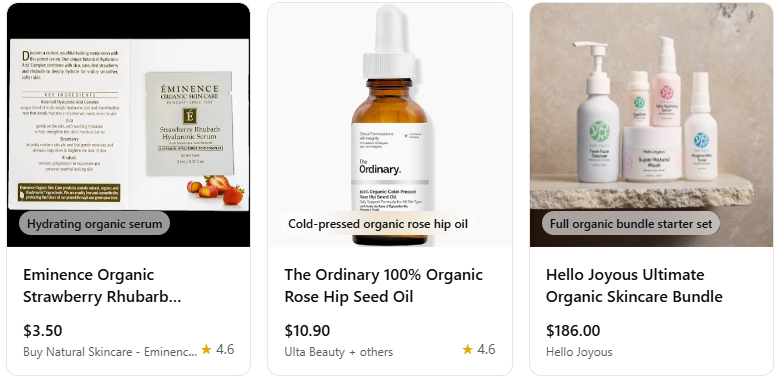
My take:
Despite being clean and non-toxic, Youth to the People doesn't appear when those specific terms are used. The Ordinary and certified organic brands dominate instead.
Result:
Featured prominently
What appeared instead:
Various starter kits from Herbivore, The Ordinary, and other accessible clean beauty brands

My take:
Youth to the People’s presence in “starter kit” searches highlights their appeal to both new and seasoned skincare shoppers. Their thoughtfully curated sets provide an inviting gateway into clean, ingredient-focused skincare, positioning the brand as a trusted choice for those starting their routine with quality from day one.
Result:
Missing entirely
What appeared:
Youth To The People mentioned alongside Herbivore, Pacifica, and other ethical beauty brands
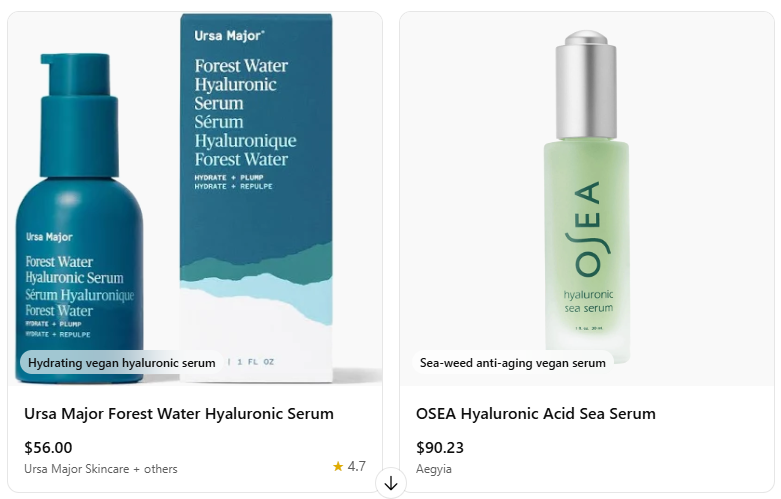
My take:
Youth to the People’s absence in “vegan + cruelty-free” searches suggests an opportunity to strengthen visibility where their ethical stance could resonate strongly with conscious beauty shoppers.
Result:
Featured prominently
What appeared:
Youth To The People Superfood Antioxidant Cleanser ($36), Herbivore Emerald Deep Moisture Glow Oil ($48)
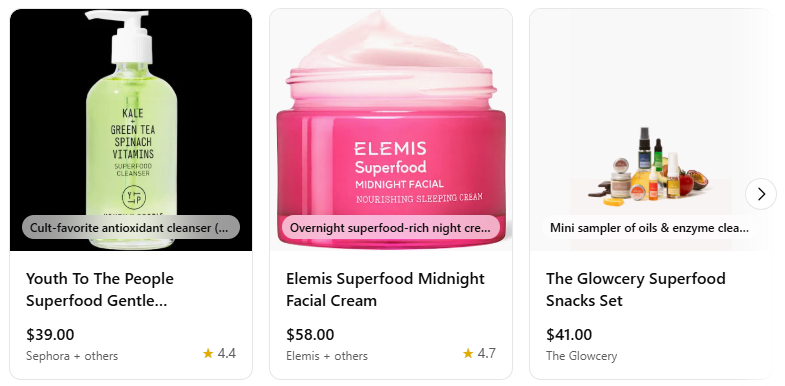
My take:
This makes perfect sense. When someone searches specifically for "superfood skincare," Youth to the People dominates because it's their core positioning. This is their strongest category.
Result:
Featured prominently
What appeared:
Youth To The People Superfood Antioxidant Cleanser ($36), Pacifica Sea Foam Complete Face Wash ($14)
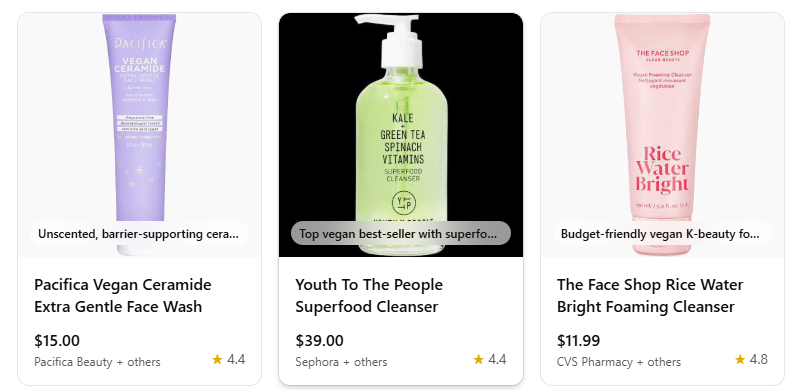
My take:
Strong positioning in vegan cleansers. Their Superfood cleanser is clearly well-categorized as vegan by AI systems, showing alongside more affordable options.
Result:
Missing entirely
What appeared:
Krave Beauty Great Barrier Relief ($28), The Ordinary Niacinamide 10% + Zinc 1% ($6.90)
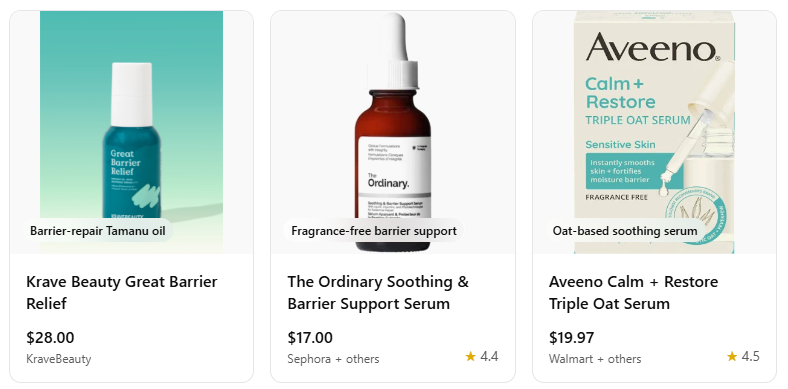
My take:
Despite having serums, Youth to the People doesn't appear in sensitive skin-focused searches. More clinical/dermatology-focused brands dominate.
Result:
Missing entirely
What appeared:
CeraVe, Neutrogena, and other gentle, dermatologist-recommended cleansers
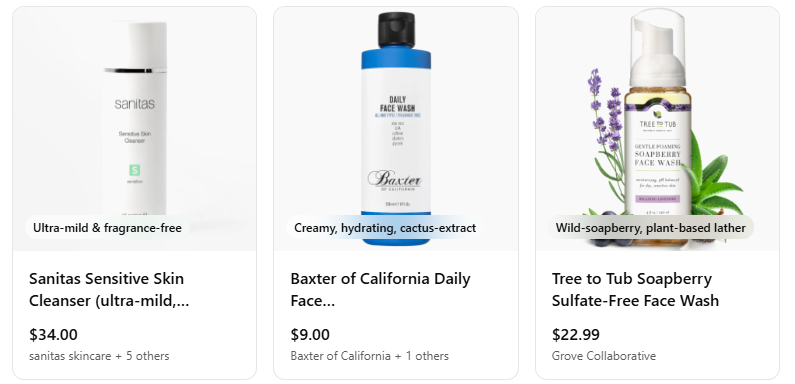
My take: Despite their Superfood cleanser being sulfate-free, they don't appear in sulfate-free specific searches. More clinical brands dominate functional searches.
Result:
Missing entirely
What appeared:
Farmacy Honey Halo ($45), La Roche-Posay Toleriane Double Repair ($19.99)
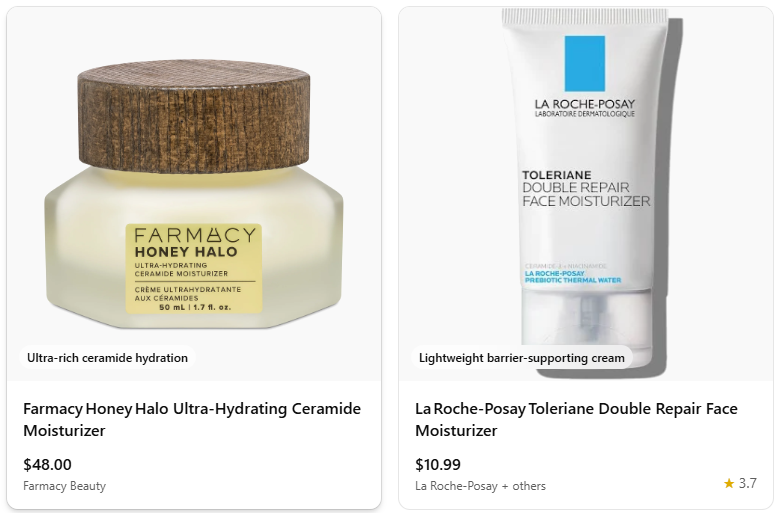
My take:
Youth to the People's moisturizers aren't surfacing in hydration-focused searches. This suggests their products aren't strongly associated with specific functional benefits.
Result:
Missing entirely
What appeared:
Herbivore, Indie Lee, Juice Beauty positioned as alternatives
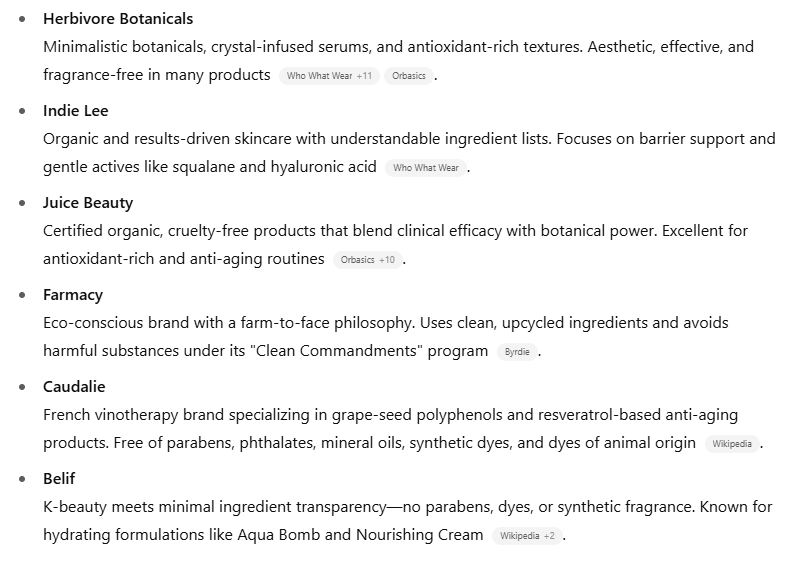
My take:
This one surprised me. Youth to the People operates in a similar price range and clean positioning as Drunk Elephant, yet doesn't appear as an alternative. Herbivore seems to own this competitive positioning.
The standout finding: Youth to the People appeared in 4 out of 10 search results, while other skincare brands surfaced more consistently across multiple categories.
Why this might be happening: AI systems seem to recognize Youth to the People best when their core positioning keywords (like “superfood skincare,” “vegan,” or “clean beauty”) are explicitly mentioned. However, their product data may not be structured in a way that ensures consistent category-level discovery. This creates gaps when queries are broader where their offerings technically qualify but are not surfaced.
Working Theory: Brands with tighter product tagging, consistent ingredient labeling, and broader category coverage tend to rank higher in AI-driven search.
The Superfood Specialization Trade-off: Youth to the People excels when searches align with their specific positioning (superfood, vegan cleanser) but struggles with broader category discovery. This suggests their brand messaging is so focused on "superfoods" that AI systems primarily categorize them within that niche.
Category Performance Breakdown:
Seeing similar patterns in your beauty brand? Don't guess about your AI visibility.
Check Your Brand's AI Readiness →
See how your brand performs across multiple AI systems. Then manually test the 10-query framework above.
For clean beauty brands: Having "clean" in your positioning doesn't guarantee visibility in clean beauty searches. You need structured product data that clearly communicates both your niche differentiation AND broader category relevance.
For ingredient-focused brands: Specific ingredient stories (superfoods, ceramides, peptides) help in targeted searches but may limit broader category visibility. Consider how to signal both specificity and category breadth.
For premium clean brands: Price positioning affects discovery patterns. Premium brands may need to optimize for both aspirational and accessible search terms.
The catalog factor: Brands that appear consistently across varied searches likely have comprehensive product categorization that includes both specific attributes (vegan, sulfate-free) and general category signals (cleanser, moisturizer, serum).
Check your brand's baseline AI visibility. Start here →
Which categories are you missing from? Where do competitors appear instead of you?
Optimize your product information for AI systems. Try our catalog tool →
Re-run tests monthly to track improvement and catch new patterns.
Based on this research, I've built several tools to help brands optimize for AI discovery:
• AI Readiness Scanner → Test your brand across multiple AI systems
• LLMs.txt Generator → Help AI systems understand your products
• Catalog Genius → Structure product data for better discovery
• AI Search Demo → See intelligent product discovery in action
Want your brand tested?
I'm building a research database of how beauty brands appear in AI discovery systems.
Suggest a brand for analysis →
Testing method:
Fresh ChatGPT-4 sessions, purchase-intent queries, conducted August 4, 2025. This analysis examines publicly available AI responses for research purposes.
Study limitations:
Single AI platform (ChatGPT-4), point-in-time snapshot, purchase-intent queries only. Results may vary across different AI systems and time periods.
Tools used: AI readiness scanner, LLMs.txt generator, and catalog optimization agent for analyzing brand discoverability patterns.
© 2025 AI Brand Intelligence by Atomz. Forward freely, just keep this notice intact.
Streamline your workflow, achieve more
Richard Thomas
Create buying intent instantly
Create buying intent before customers search. 25%+ conversion lift guaranteed.
Why Prompts Matter
AI Search That Converts 3x Better
Get the latest in AI-powered search, UX trends, and eCommerce conversions—straight to your inbo
No spam. Just powerful insights.
👉 Join thousands of growth-focused brands.

